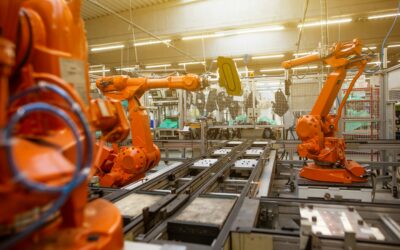In today’s fast-paced business environment, customer satisfaction is paramount. However, many organizations still rely on manual processes that can hinder their ability to deliver exceptional service. When customer interactions are bogged down by outdated systems and inefficient workflows, the result is often frustration for both customers and employees.
Manual processes can lead to delays in response times, miscommunication, and a lack of consistency in service delivery. This inconsistency can erode trust and loyalty, making it difficult for businesses to retain customers in an increasingly competitive landscape. Moreover, the reliance on manual processes can create a disconnect between what customers expect and what businesses can deliver.
Customers today are accustomed to instant gratification and seamless experiences, thanks to advancements in technology. When businesses fail to meet these expectations due to cumbersome manual workflows, they risk losing valuable customers. By adopting a more streamlined approach through platforms like SMS-iT, organizations can automate their processes, ensuring that customer interactions are timely, efficient, and ultimately satisfying.
This shift not only enhances customer satisfaction but also positions businesses for long-term success.
Key Takeaways
- Manual processes significantly reduce customer satisfaction and slow response times.
- Inefficient customer experience leads to financial losses and missed sales opportunities.
- Employee morale and productivity decline due to repetitive, error-prone tasks.
- Inaccurate data and human errors hinder effective decision-making and reporting.
- Neglecting automation harms brand reputation and limits scalability for growth.
The Financial Burden of Inefficient Customer Experience
The financial implications of an inefficient customer experience can be staggering. When businesses operate with outdated systems and manual processes, they often incur hidden costs that can significantly impact their bottom line. For instance, the time spent by employees on repetitive tasks could be better utilized in more strategic areas that drive revenue growth.
Additionally, the costs associated with customer churn—such as lost sales and the expense of acquiring new customers—can quickly add up. Investing in a comprehensive solution like SMS-iT can alleviate these financial burdens by automating key processes and optimizing customer interactions. By streamlining operations, businesses can reduce overhead costs and improve their overall efficiency.
This not only leads to a healthier bottom line but also allows organizations to allocate resources more effectively, ultimately driving growth and profitability. The transition from manual processes to an integrated platform is not just a technological upgrade; it’s a strategic move that can yield significant financial benefits.
Missed Opportunities for Upselling and Cross-Selling
In the realm of customer experience, missed opportunities for upselling and cross-selling can be detrimental to a business’s growth potential. When organizations rely on manual processes, they often lack the insights needed to identify when a customer is ready for an additional purchase or an upgrade. This oversight not only results in lost revenue but also signifies a failure to engage customers at critical moments in their journey.
With SMS-iT’s advanced capabilities, businesses can harness data-driven insights to identify upselling and cross-selling opportunities seamlessly. By automating customer interactions and utilizing predictive analytics, organizations can tailor their offerings to meet individual customer needs. This personalized approach not only enhances the customer experience but also drives additional revenue streams.
By embracing automation, businesses can transform missed opportunities into strategic advantages, ensuring they capitalize on every potential sale.
The Toll on Employee Morale and Productivity
The impact of manual processes extends beyond customer satisfaction; it also takes a toll on employee morale and productivity. When employees are burdened with repetitive tasks and inefficient workflows, their motivation can wane. Frustration stemming from cumbersome systems can lead to burnout, decreased job satisfaction, and ultimately higher turnover rates.
This cycle not only affects individual employees but also disrupts team dynamics and overall organizational performance. By implementing SMS-iT, businesses can empower their employees with tools that streamline workflows and reduce the burden of manual tasks. Automation allows employees to focus on higher-value activities that require creativity and critical thinking, fostering a more engaged workforce.
When employees feel supported by efficient systems, their morale improves, leading to increased productivity and better service delivery. Investing in automation is not just about enhancing operational efficiency; it’s about creating a positive work environment that nurtures talent and drives success.
Inaccurate Data and Reporting
Inaccurate data can cripple decision-making processes within an organization. When businesses rely on manual data entry and fragmented systems, the risk of errors increases significantly. These inaccuracies can lead to misguided strategies, misallocation of resources, and ultimately poor business outcomes.
In today’s data-driven world, having access to reliable information is crucial for making informed decisions that drive growth. SMS-iT addresses this challenge by providing a unified platform that ensures data accuracy and consistency across all touchpoints. By automating data collection and reporting processes, businesses can eliminate the risk of human error and gain real-time insights into their operations.
This level of accuracy not only enhances decision-making but also builds trust with stakeholders who rely on data-driven insights for strategic planning. With SMS-iT, organizations can transform their approach to data management, ensuring they have the information they need to succeed.
Increased Risk of Human Error
Human error is an inevitable part of any business operation, particularly when manual processes are involved. From data entry mistakes to miscommunication between departments, the potential for errors increases significantly without the support of automated systems. These errors can have far-reaching consequences, affecting everything from customer satisfaction to financial performance.
By leveraging SMS-iT’s automation capabilities, businesses can significantly reduce the risk of human error in their operations. Automation streamlines processes, ensuring that tasks are completed accurately and consistently every time. This not only enhances operational efficiency but also instills confidence in customers who expect reliable service.
By minimizing errors through automation, organizations can focus on delivering exceptional experiences rather than constantly rectifying mistakes.
The Slow Response Time to Customer Inquiries
In an age where customers expect immediate responses, slow response times can be detrimental to a business’s reputation. Manual processes often lead to delays in addressing customer inquiries, resulting in frustration and dissatisfaction. Customers today have numerous options at their fingertips; if they feel ignored or undervalued due to slow service, they are likely to take their business elsewhere.
SMS-iT revolutionizes the way businesses handle customer inquiries by automating responses and streamlining communication channels. With features like chatbots and automated email responses, organizations can ensure that customers receive timely assistance regardless of the time of day. This proactive approach not only enhances customer satisfaction but also positions businesses as responsive and attentive—qualities that are essential for building long-term relationships.
Lack of Personalization and Customization
In a world where personalization is key to customer engagement, relying on manual processes often results in generic interactions that fail to resonate with individual customers. Customers today expect tailored experiences that reflect their unique preferences and needs; when businesses fall short in this area, they risk losing valuable connections. SMS-iT empowers organizations to deliver personalized experiences at scale by leveraging data analytics and automation.
By understanding customer behavior and preferences through integrated systems, businesses can create targeted marketing campaigns and customized offerings that speak directly to their audience. This level of personalization not only enhances customer satisfaction but also fosters loyalty—ensuring that customers feel valued and understood.
The Negative Impact on Brand Reputation
A business’s reputation is one of its most valuable assets; however, it can be easily tarnished by poor customer experiences stemming from manual processes. Negative reviews and word-of-mouth referrals can spread quickly in today’s digital age, making it essential for organizations to prioritize customer satisfaction at every touchpoint. By adopting SMS-iT’s comprehensive automation solutions, businesses can enhance their brand reputation by consistently delivering exceptional service.
Automation ensures that customers receive timely responses, personalized interactions, and accurate information—factors that contribute significantly to positive experiences. A strong brand reputation built on reliability and excellence not only attracts new customers but also retains existing ones, creating a cycle of growth that benefits the entire organization.
Difficulty in Scaling and Meeting Growing Customer Demands
As businesses grow, so do customer demands; however, manual processes often hinder an organization’s ability to scale effectively. When systems are fragmented and workflows are inefficient, it becomes increasingly challenging to meet the needs of a growing customer base without sacrificing quality or service levels. SMS-iT provides a scalable solution that allows businesses to adapt quickly to changing demands without compromising on service quality.
By automating key processes and integrating various functions into one cohesive platform, organizations can efficiently manage increased workloads while maintaining high standards of service delivery. This scalability ensures that businesses are well-equipped to handle growth while continuing to provide exceptional experiences for their customers.
The Long-Term Consequences of Neglecting Customer Experience Automation
Neglecting customer experience automation can have long-term consequences that extend far beyond immediate operational challenges. Businesses that fail to embrace automation risk falling behind competitors who leverage technology to enhance their service delivery. Over time, this neglect can lead to declining customer loyalty, increased churn rates, and ultimately diminished market share.
By investing in SMS-iT’s innovative automation solutions now, organizations can position themselves for long-term success in an ever-evolving marketplace. Embracing automation not only streamlines operations but also fosters a culture of continuous improvement focused on delivering exceptional customer experiences. The long-term benefits of prioritizing automation far outweigh the initial investment—ensuring that businesses remain competitive while building lasting relationships with their customers.
In conclusion, the impact of manual processes on various aspects of business operations cannot be overstated. From customer satisfaction to employee morale and brand reputation, the consequences of inefficiency are far-reaching. By adopting SMS-iT’s comprehensive automation platform, organizations can transform their operations into a streamlined ecosystem that empowers them to thrive in today’s competitive landscape.
Don’t wait—experience the benefits of SMS-iT for yourself with a 7-day free trial at https://www.smsit.ai!
FAQs
What does automating customer experience mean?
Automating customer experience involves using technology, such as software and artificial intelligence, to streamline and enhance interactions between a business and its customers. This can include automated responses, personalized communication, and self-service options.
What are the hidden costs of not automating customer experience?
The hidden costs include decreased customer satisfaction, longer response times, higher operational expenses due to manual processes, increased employee workload, and potential loss of customers to competitors who offer faster, more efficient service.
How does manual customer service impact business efficiency?
Manual customer service often leads to slower response times, inconsistent service quality, and increased chances of human error. This inefficiency can reduce overall productivity and increase costs.
Can automating customer experience improve customer satisfaction?
Yes, automation can provide faster responses, 24/7 availability, and personalized interactions, all of which contribute to higher customer satisfaction and loyalty.
Is automation suitable for all types of customer interactions?
While automation is effective for routine inquiries and tasks, complex or sensitive issues may still require human intervention to ensure empathy and nuanced understanding.
What technologies are commonly used to automate customer experience?
Common technologies include chatbots, automated email responders, customer relationship management (CRM) systems, artificial intelligence, and machine learning tools.
Does automating customer experience reduce operational costs?
Yes, automation can reduce the need for large customer service teams, minimize errors, and speed up processes, leading to lower operational costs over time.
How can businesses measure the impact of automating customer experience?
Businesses can track metrics such as customer satisfaction scores, response times, resolution rates, customer retention, and cost savings to evaluate the effectiveness of automation.
Are there risks associated with automating customer experience?
Potential risks include over-reliance on automation leading to impersonal service, technical failures, and the possibility of alienating customers who prefer human interaction.
What steps should a business take before automating customer experience?
Businesses should assess customer needs, identify repetitive tasks suitable for automation, choose appropriate technologies, train staff, and continuously monitor and optimize automated systems.









